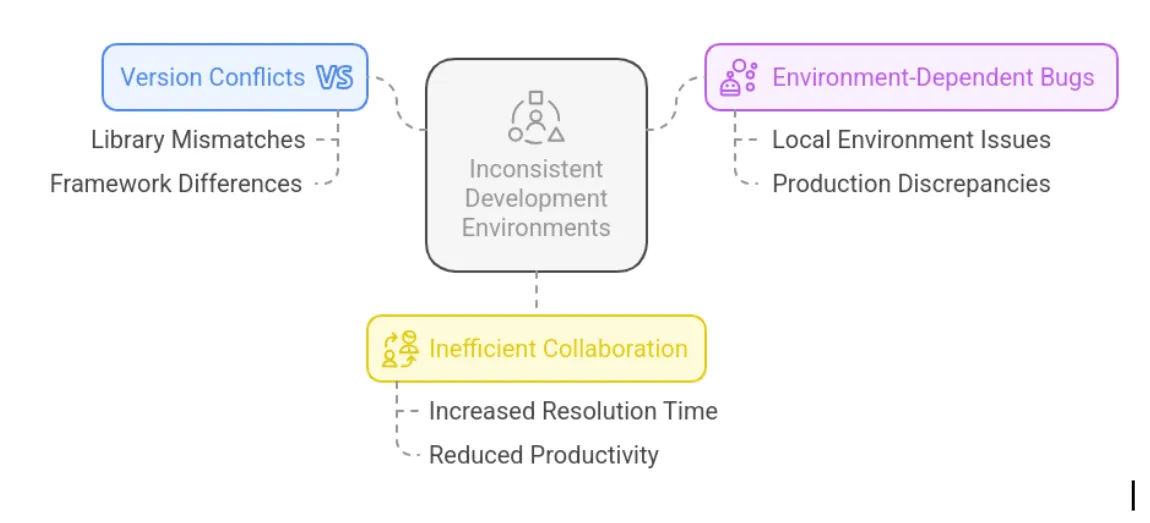March 19, 2025
The Hidden Costs of Not Having a Standardized Development Platform

By Priyank Dhami
Improwised Technologies Pvt. Ltd.

Inconsistent Environments and Integration Challenges
One of the most significant hidden costs of not having a standardized development platform is the proliferation of inconsistent environments across the development team. When developers work in disparate environments, even minor differences in tool versions, configurations, or dependencies can lead to integration challenges. For example, a developer using Node.js 18.0.0 might encounter compatibility issues with a teammate using Node.js 16.0.0, especially when relying on shared dependencies.
These inconsistencies can manifest in various ways, such as:
-
Version Conflicts: Different versions of libraries or frameworks can lead to unexpected behavior when integrating code from multiple developers. For instance, a feature that works locally for one developer might fail when merged into the main branch due to version mismatches.
-
Environment-Dependent Bugs: Bugs that appear only in specific environments can be difficult to reproduce and debug. For example, a bug that occurs in a developer’s local environment but not in the production environment can waste significant time and resources.
-
Inefficient Collaboration: Without a standardized environment, developers spend more time resolving integration issues rather than focusing on feature development. This friction can slow down the entire development process and reduce team productivity.
Increased Support and Maintenance Overhead
Another hidden cost is the increased support and maintenance overhead that comes with managing multiple, non-standard environments. When developers are allowed to customize their environments freely, the support team must handle a wider range of configurations, leading to:
-
Prolonged Troubleshooting: Support teams must spend more time diagnosing issues that arise from environment-specific configurations. For example, a developer using a custom setup might encounter issues that are not replicable in the standard environment, making it harder for the support team to identify the root cause.
-
Higher Operational Complexity: Managing multiple environments requires additional resources and tools. For instance, organizations might need to maintain separate build scripts, CI/CD pipelines, and monitoring setups for different environments, increasing operational complexity.
-
Reduced Efficiency in Issue Resolution: The lack of a standardized environment can lead to longer resolution times for issues. For example, a bug that could be resolved quickly in a standardized environment might take significantly longer to diagnose and fix in a non-standard setup.
Security Vulnerabilities and Compliance Risks
Standardized development platforms play a crucial role in maintaining security and compliance. Without a standardized environment, organizations face increased security risks and compliance challenges. For example:
-
Inconsistent Security Configurations: Developers working in non-standard environments might have different security settings, leading to vulnerabilities. For instance, one developer might disable certain security features to improve performance, unknowingly exposing the application to potential attacks.
-
Difficulty in Enforcing Security Policies: Organizations find it challenging to enforce security policies across multiple environments. For example, ensuring that all developers use up-to-date versions of libraries or follow secure coding practices becomes more difficult when environments are not standardized.
-
Increased Attack Surface: Non-standard environments can increase the attack surface, as different configurations might introduce vulnerabilities that attackers can exploit. For instance, a developer using an outdated version of a library might inadvertently introduce a known vulnerability into the application.
Slowed Onboarding and Knowledge Sharing
The absence of a standardized development platform can also hinder the onboarding process for new developers and reduce knowledge sharing within the team. For example:
-
Lengthy Onboarding Process: New developers must spend more time setting up their environment and learning the specific tools and configurations used by the team. This can delay their contribution to the project and reduce overall team productivity.
-
Reduced Knowledge Sharing: Without a standardized environment, developers might have difficulty sharing knowledge and best practices. For instance, a developer who has optimized their environment for performance might find it challenging to share their setup with others, leading to duplicated effort and reduced efficiency.
-
Increased Learning Curve: New developers must learn multiple environments and configurations, increasing the learning curve and reducing their ability to contribute effectively to the project.
Inefficient Resource Utilization
Another hidden cost of not having a standardized development platform is inefficient resource utilization. Without a standardized environment, organizations might find it challenging to optimize resource usage, leading to:
-
Underutilized Infrastructure: Developers might use different tools and configurations, leading to underutilized infrastructure. For example, some developers might use resource-intensive tools that are not necessary for the project, while others might use tools that are underpowered.
-
Increased Costs: Inefficient resource utilization can lead to increased costs. For example, organizations might need to purchase additional hardware or software to support multiple environments, leading to higher operational expenses.
-
Difficulty in Scaling: Without a standardized environment, organizations might find it challenging to scale their development efforts. For example, adding new developers to the team might require significant time and resources to set up their environments, slowing down the scaling process.
Compliance and Audit Challenges
Finally, the absence of a standardized development platform can lead to compliance and audit challenges. Organizations must ensure that their development practices comply with industry regulations and standards, which can be more difficult without a standardized environment. For example:
-
Difficulty in Demonstrating Compliance: Organizations might find it challenging to demonstrate compliance with industry regulations when development environments are not standardized. For instance, auditors might require evidence that all developers are following specific security practices, which can be difficult to provide when environments are not consistent.
-
Increased Audit Complexity: Audits can become more complex and time-consuming when development environments are not standardized. For example, auditors might need to review multiple environments and configurations, increasing the time and resources required for the audit.
-
Higher Risk of Non-Compliance: Non-standard environments can increase the risk of non-compliance with industry regulations. For example, developers might inadvertently introduce non-compliant practices into their environments, leading to potential legal and financial consequences.
Conclusion
The hidden costs of not having a standardized development platform are significant and far-reaching. From inconsistent environments and integration challenges to increased support and maintenance overhead, security vulnerabilities, slowed onboarding, inefficient resource utilization, and compliance risks, the absence of a standardized platform can have a profound impact on an organization’s ability to deliver high-quality software efficiently and securely.
To mitigate these costs, organizations should consider implementing a standardized development platform that ensures consistency across all development environments. By doing so, they can reduce the risks associated with non-standard environments, improve collaboration and knowledge sharing, and ensure compliance with industry regulations.

November 19, 2025
Unlocking Developer Potential: How Platform Engineering Transforms Developer Experience

By Shyam Kapdi
Improwised Technologies
Pvt. Ltd.


By Shyam Kapdi
Improwised Technologies
Pvt. Ltd.

November 14, 2025
How to Build a High-Impact Internal Developer Platform: Step-by-Step Blueprint, Tools, and Best Practices

By Shyam Kapdi
Improwised Technologies
Pvt. Ltd.
Optimize Your Cloud. Cut Costs. Accelerate Performance.
Struggling with slow deployments and rising cloud costs?
Our tailored platform engineering solutions enhance efficiency, boost speed, and reduce expenses.
